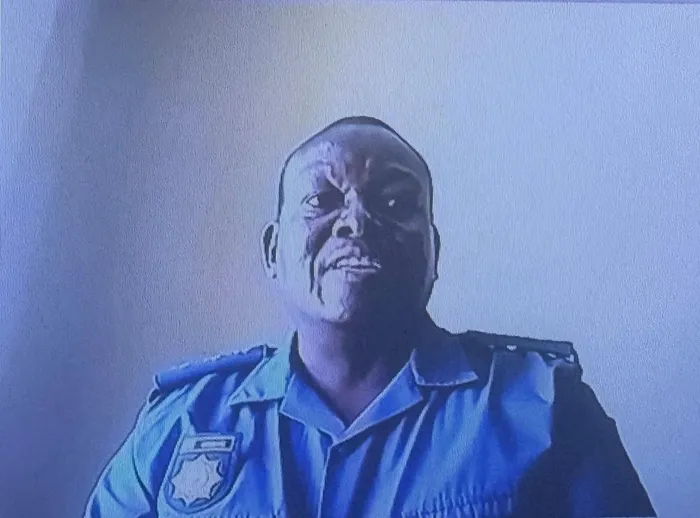Guns in ‘KT’ Molefe’s case were recovered by cops but found their way back into criminal hands

Captain Solomon Modisane, a senior SAPS forensic analyst attached to the KZN Political Killings Task Team, told the Madlanga Commission that it took him one day to link the cases of DJ Sumbody, DJ Vintos, Don Tindleni and the Bramley case.
Image: Screenshot
The firearms confiscated in Bramley from suspects linked to the Armand Swart murder case, which were taken to the KwaZulu-Natal Forensic lab for a second ballistics opinion, had previously been seized as evidence by the police, but were never entered into an SAP13, the administrative process.
This was revealed to the Madlanga Commission of Inquiry on Monday, during the testimony of Captain Solomon Modisane, a senior SAPS forensic analyst attached to the KZN Political Killings Task Team (PKTT).
Modisane stated that on 30 December 2024, he was requested to compare the exhibits from the murder cases of Oupa ‘DJ Sumbody’ Sefoka, Hector ‘DJ Vintos’ Buthelezi, and Don Tindleni with the Bramley case, where the suspects in the murder of Swart were arrested.
Swart, a Vereeniging engineer, was gunned down on April 17, 2025, in a case of mistaken identity. The hitmen allegedly mistook Swart for a colleague who had exposed corruption in a tender linked to Transnet.
Controversial businessman Katiso ‘KT’ Molefe was charged with Swart’s murder, alongside three alleged hitmen, Warrant Officer Michael Pule Tau, Musa Kekana, and Tiego Floyd Mabusela.
The witness said: “I was requested to compare the fired cartridge cases and the fired bullets under the microscope, which means I was not doing a full examination from scratch,” he said.
The forensic expert said he then examined all the exhibits inside the evidence bags.
“All these exhibits that I have mentioned, the cartridge cases were fired in the same firearm. So, they bear a common origin. This specific firearm I’m referring to is a 7.62x39 mm calibre Russian Kalashnikov model AK-47, a fully automatic assault rifle. That AK-47 is the same AK-47 that was found on the suspects who were arrested in Bramley. This is the same firearm that murdered DJ Sumbody, DJ Vintos, and Tindleni,” he said.
Modisane then added that he also examined the 9mm Parabellum cartridge cases that were found at the crime scene of the murder of DJ Vintos. He then compared them with the exhibits from Tindleni’s crime scene.
“I found that they were fired from a common firearm. This firearm is the 9mm Parabellum Taurus Model PT92FS, it is a semi-automatic pistol, and the serial number was obliterated. Later, the serial number of this specific firearm was retrieved during the etching process (by Warrant Officer Ruwain Kader, a forensic ballistics expert who works in KwaZulu-Natal). This firearm was accompanied by the AK-47,” Modisane said.
This Parabellum Taurus, according to the witness, is the same firearm that Captain Itumeleng Makgotloe, a forensic analyst in Pretoria, was unable to retrieve the serial number.
Modisane added that the findings were not made in light of the bullet jackets due to damage that happened at the point of being fired. He added that these were high-caliber firearms, and when the bullets meet the target, it disintegrates into smaller pieces.
It was also noted that the firearms were once recovered by the police.
Advocate Thabang Pooe, the Commission’s evidence leader, said: “Just to note on the etching process, we have followed up with Witnesses A, B, and C to provide us with the supplementary (information) dealing with their findings when they took the serial number (that had been) discovered. They noted that the weapons were previously recovered by police, but were not entered into SAP13, which is the administrative process. We have asked for an affidavit in that regard.”
Asked about possible reasons for non-retrieval of serial numbers from the firearms, Modisane said, sometimes it is inadequate training, a person not willing to go an extra mile to try and retrieve the serial number, expired chemicals, or the person deliberately not doing his or her job.
Describing the importance of a serial number in a firearm, he said it shows the identity, the history, the original owner, and how the firearm was taken from them.
Asked about how long it took him to link the cases, he said that he completed the comparisons in one day.
“The whole exercise took only one day. In the PKTT, we have a motivating factor. We work on the case until we finish. This is unique to the PKTT. Our (SAPS Ballistics nationally) normal working turnaround time is 30 days. We made our own turnaround time at PKTT to be three days,” Modisane said.
The Madlanga Commission of Inquiry is investigating allegations of collusion and corruption between politicians, senior police, prosecutors, intelligence operatives, and elements of the judiciary, levelled by KwaZulu-Natal Provincial Police Commissioner Lieutenant General Nhlanhla Mkhwanazi.